The medical procedures to the patients
VerifiedAdded on 2022/09/14
|8
|2489
|20
AI Summary
Contribute Materials
Your contribution can guide someone’s learning journey. Share your
documents today.
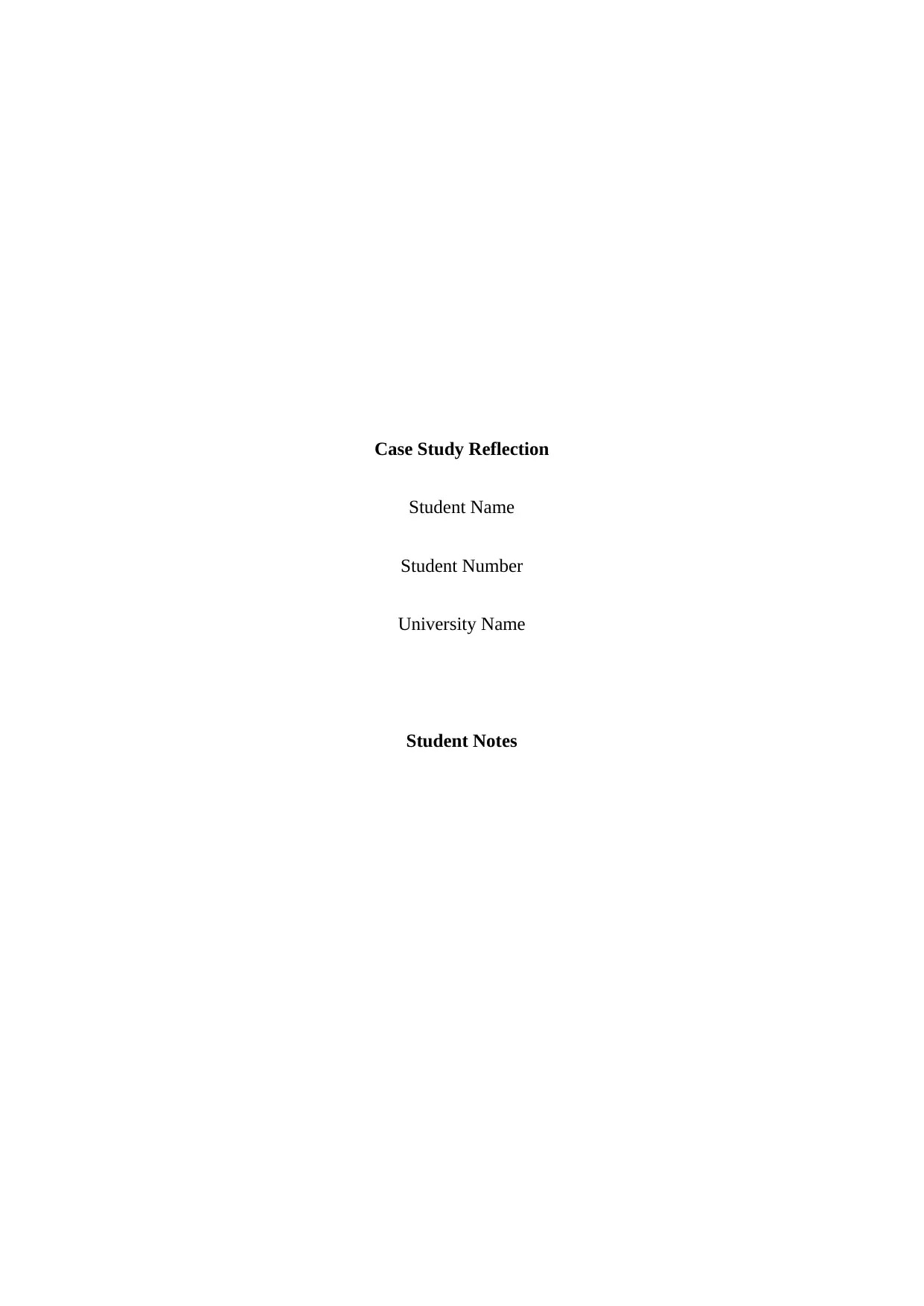
Case Study Reflection
Student Name
Student Number
University Name
Student Notes
Student Name
Student Number
University Name
Student Notes
Secure Best Marks with AI Grader
Need help grading? Try our AI Grader for instant feedback on your assignments.
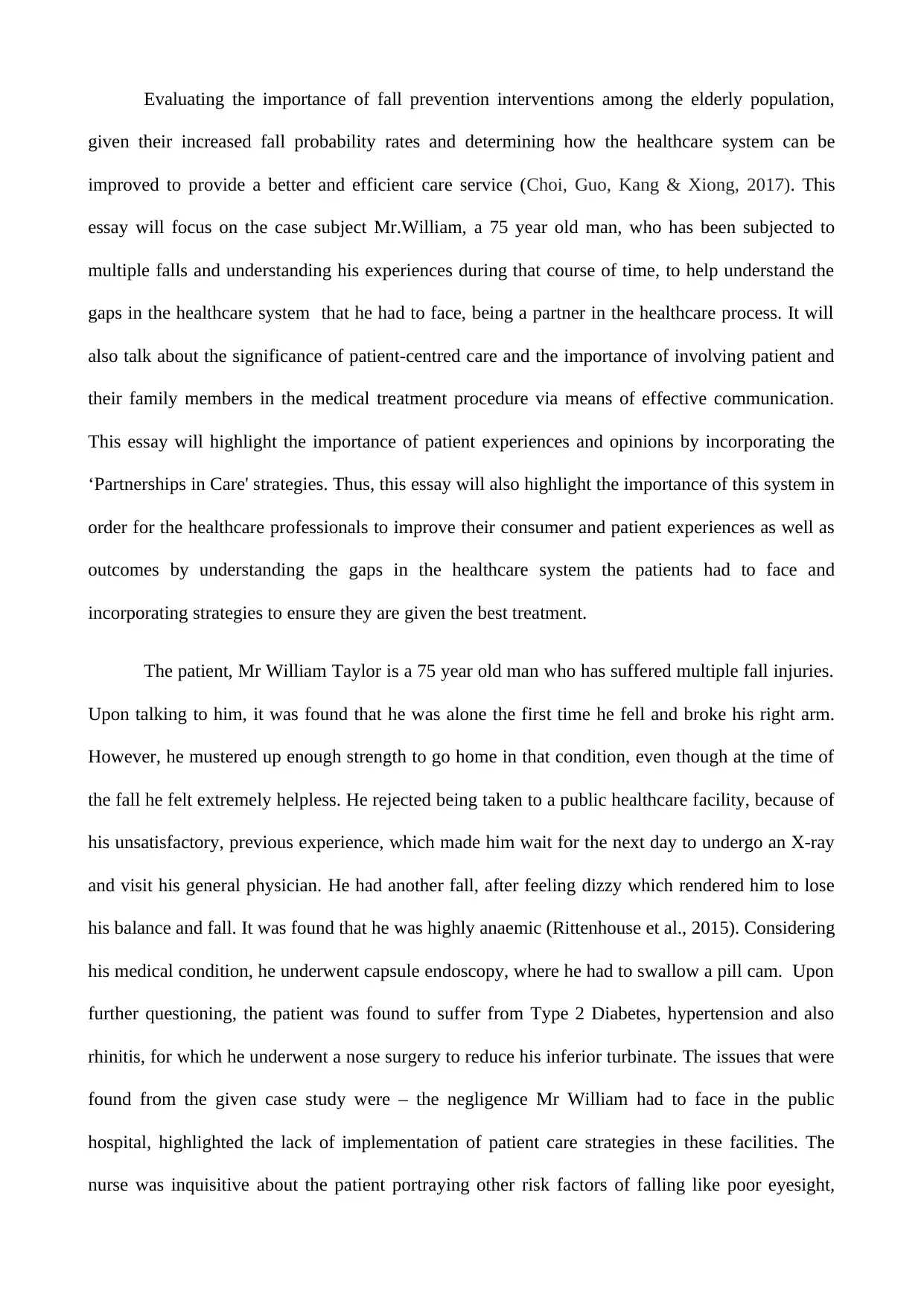
Evaluating the importance of fall prevention interventions among the elderly population,
given their increased fall probability rates and determining how the healthcare system can be
improved to provide a better and efficient care service (Choi, Guo, Kang & Xiong, 2017). This
essay will focus on the case subject Mr.William, a 75 year old man, who has been subjected to
multiple falls and understanding his experiences during that course of time, to help understand the
gaps in the healthcare system that he had to face, being a partner in the healthcare process. It will
also talk about the significance of patient-centred care and the importance of involving patient and
their family members in the medical treatment procedure via means of effective communication.
This essay will highlight the importance of patient experiences and opinions by incorporating the
‘Partnerships in Care' strategies. Thus, this essay will also highlight the importance of this system in
order for the healthcare professionals to improve their consumer and patient experiences as well as
outcomes by understanding the gaps in the healthcare system the patients had to face and
incorporating strategies to ensure they are given the best treatment.
The patient, Mr William Taylor is a 75 year old man who has suffered multiple fall injuries.
Upon talking to him, it was found that he was alone the first time he fell and broke his right arm.
However, he mustered up enough strength to go home in that condition, even though at the time of
the fall he felt extremely helpless. He rejected being taken to a public healthcare facility, because of
his unsatisfactory, previous experience, which made him wait for the next day to undergo an X-ray
and visit his general physician. He had another fall, after feeling dizzy which rendered him to lose
his balance and fall. It was found that he was highly anaemic (Rittenhouse et al., 2015). Considering
his medical condition, he underwent capsule endoscopy, where he had to swallow a pill cam. Upon
further questioning, the patient was found to suffer from Type 2 Diabetes, hypertension and also
rhinitis, for which he underwent a nose surgery to reduce his inferior turbinate. The issues that were
found from the given case study were – the negligence Mr William had to face in the public
hospital, highlighted the lack of implementation of patient care strategies in these facilities. The
nurse was inquisitive about the patient portraying other risk factors of falling like poor eyesight,
given their increased fall probability rates and determining how the healthcare system can be
improved to provide a better and efficient care service (Choi, Guo, Kang & Xiong, 2017). This
essay will focus on the case subject Mr.William, a 75 year old man, who has been subjected to
multiple falls and understanding his experiences during that course of time, to help understand the
gaps in the healthcare system that he had to face, being a partner in the healthcare process. It will
also talk about the significance of patient-centred care and the importance of involving patient and
their family members in the medical treatment procedure via means of effective communication.
This essay will highlight the importance of patient experiences and opinions by incorporating the
‘Partnerships in Care' strategies. Thus, this essay will also highlight the importance of this system in
order for the healthcare professionals to improve their consumer and patient experiences as well as
outcomes by understanding the gaps in the healthcare system the patients had to face and
incorporating strategies to ensure they are given the best treatment.
The patient, Mr William Taylor is a 75 year old man who has suffered multiple fall injuries.
Upon talking to him, it was found that he was alone the first time he fell and broke his right arm.
However, he mustered up enough strength to go home in that condition, even though at the time of
the fall he felt extremely helpless. He rejected being taken to a public healthcare facility, because of
his unsatisfactory, previous experience, which made him wait for the next day to undergo an X-ray
and visit his general physician. He had another fall, after feeling dizzy which rendered him to lose
his balance and fall. It was found that he was highly anaemic (Rittenhouse et al., 2015). Considering
his medical condition, he underwent capsule endoscopy, where he had to swallow a pill cam. Upon
further questioning, the patient was found to suffer from Type 2 Diabetes, hypertension and also
rhinitis, for which he underwent a nose surgery to reduce his inferior turbinate. The issues that were
found from the given case study were – the negligence Mr William had to face in the public
hospital, highlighted the lack of implementation of patient care strategies in these facilities. The
nurse was inquisitive about the patient portraying other risk factors of falling like poor eyesight,
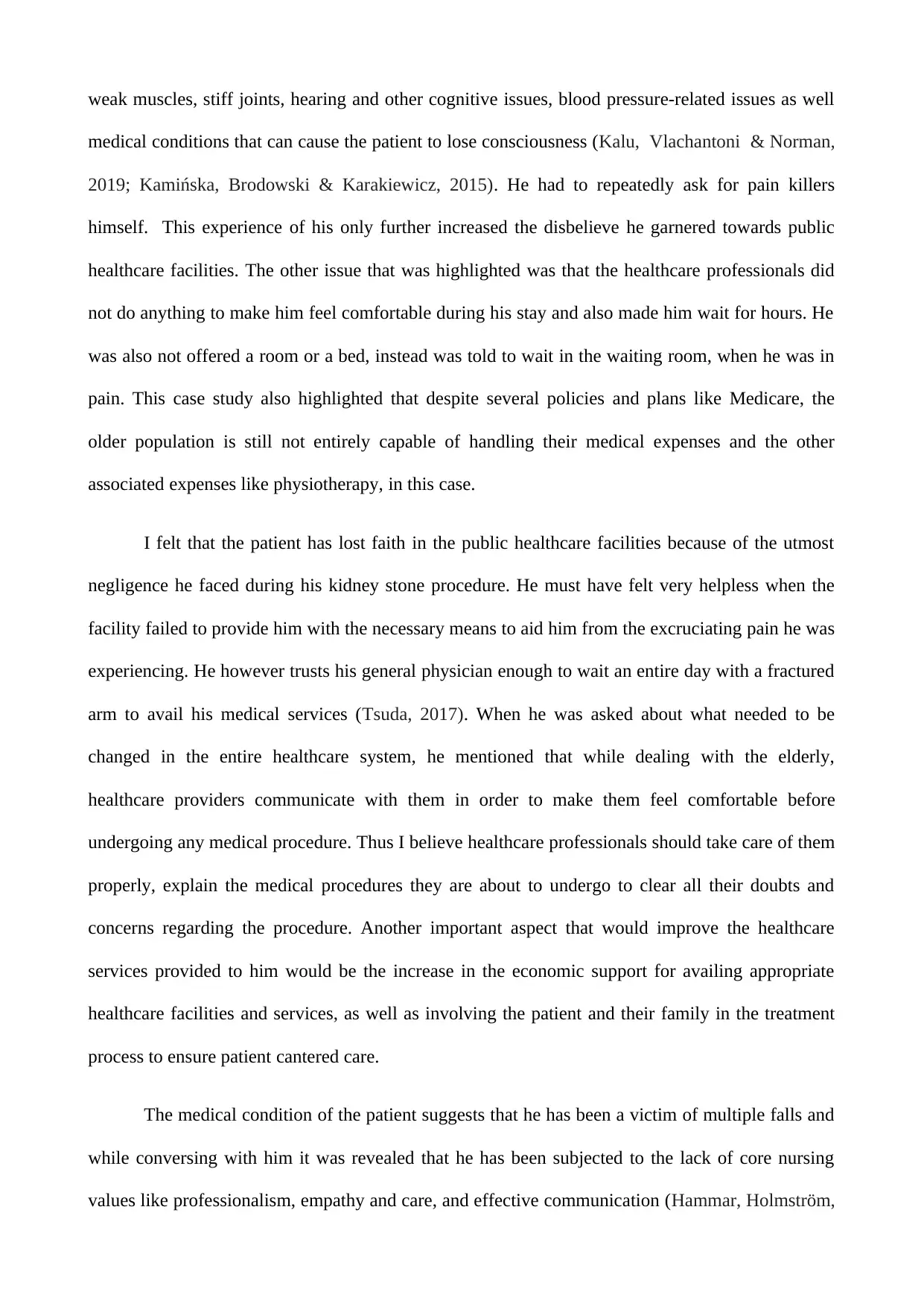
weak muscles, stiff joints, hearing and other cognitive issues, blood pressure-related issues as well
medical conditions that can cause the patient to lose consciousness (Kalu, Vlachantoni & Norman,
2019; Kamińska, Brodowski & Karakiewicz, 2015). He had to repeatedly ask for pain killers
himself. This experience of his only further increased the disbelieve he garnered towards public
healthcare facilities. The other issue that was highlighted was that the healthcare professionals did
not do anything to make him feel comfortable during his stay and also made him wait for hours. He
was also not offered a room or a bed, instead was told to wait in the waiting room, when he was in
pain. This case study also highlighted that despite several policies and plans like Medicare, the
older population is still not entirely capable of handling their medical expenses and the other
associated expenses like physiotherapy, in this case.
I felt that the patient has lost faith in the public healthcare facilities because of the utmost
negligence he faced during his kidney stone procedure. He must have felt very helpless when the
facility failed to provide him with the necessary means to aid him from the excruciating pain he was
experiencing. He however trusts his general physician enough to wait an entire day with a fractured
arm to avail his medical services (Tsuda, 2017). When he was asked about what needed to be
changed in the entire healthcare system, he mentioned that while dealing with the elderly,
healthcare providers communicate with them in order to make them feel comfortable before
undergoing any medical procedure. Thus I believe healthcare professionals should take care of them
properly, explain the medical procedures they are about to undergo to clear all their doubts and
concerns regarding the procedure. Another important aspect that would improve the healthcare
services provided to him would be the increase in the economic support for availing appropriate
healthcare facilities and services, as well as involving the patient and their family in the treatment
process to ensure patient cantered care.
The medical condition of the patient suggests that he has been a victim of multiple falls and
while conversing with him it was revealed that he has been subjected to the lack of core nursing
values like professionalism, empathy and care, and effective communication (Hammar, Holmström,
medical conditions that can cause the patient to lose consciousness (Kalu, Vlachantoni & Norman,
2019; Kamińska, Brodowski & Karakiewicz, 2015). He had to repeatedly ask for pain killers
himself. This experience of his only further increased the disbelieve he garnered towards public
healthcare facilities. The other issue that was highlighted was that the healthcare professionals did
not do anything to make him feel comfortable during his stay and also made him wait for hours. He
was also not offered a room or a bed, instead was told to wait in the waiting room, when he was in
pain. This case study also highlighted that despite several policies and plans like Medicare, the
older population is still not entirely capable of handling their medical expenses and the other
associated expenses like physiotherapy, in this case.
I felt that the patient has lost faith in the public healthcare facilities because of the utmost
negligence he faced during his kidney stone procedure. He must have felt very helpless when the
facility failed to provide him with the necessary means to aid him from the excruciating pain he was
experiencing. He however trusts his general physician enough to wait an entire day with a fractured
arm to avail his medical services (Tsuda, 2017). When he was asked about what needed to be
changed in the entire healthcare system, he mentioned that while dealing with the elderly,
healthcare providers communicate with them in order to make them feel comfortable before
undergoing any medical procedure. Thus I believe healthcare professionals should take care of them
properly, explain the medical procedures they are about to undergo to clear all their doubts and
concerns regarding the procedure. Another important aspect that would improve the healthcare
services provided to him would be the increase in the economic support for availing appropriate
healthcare facilities and services, as well as involving the patient and their family in the treatment
process to ensure patient cantered care.
The medical condition of the patient suggests that he has been a victim of multiple falls and
while conversing with him it was revealed that he has been subjected to the lack of core nursing
values like professionalism, empathy and care, and effective communication (Hammar, Holmström,
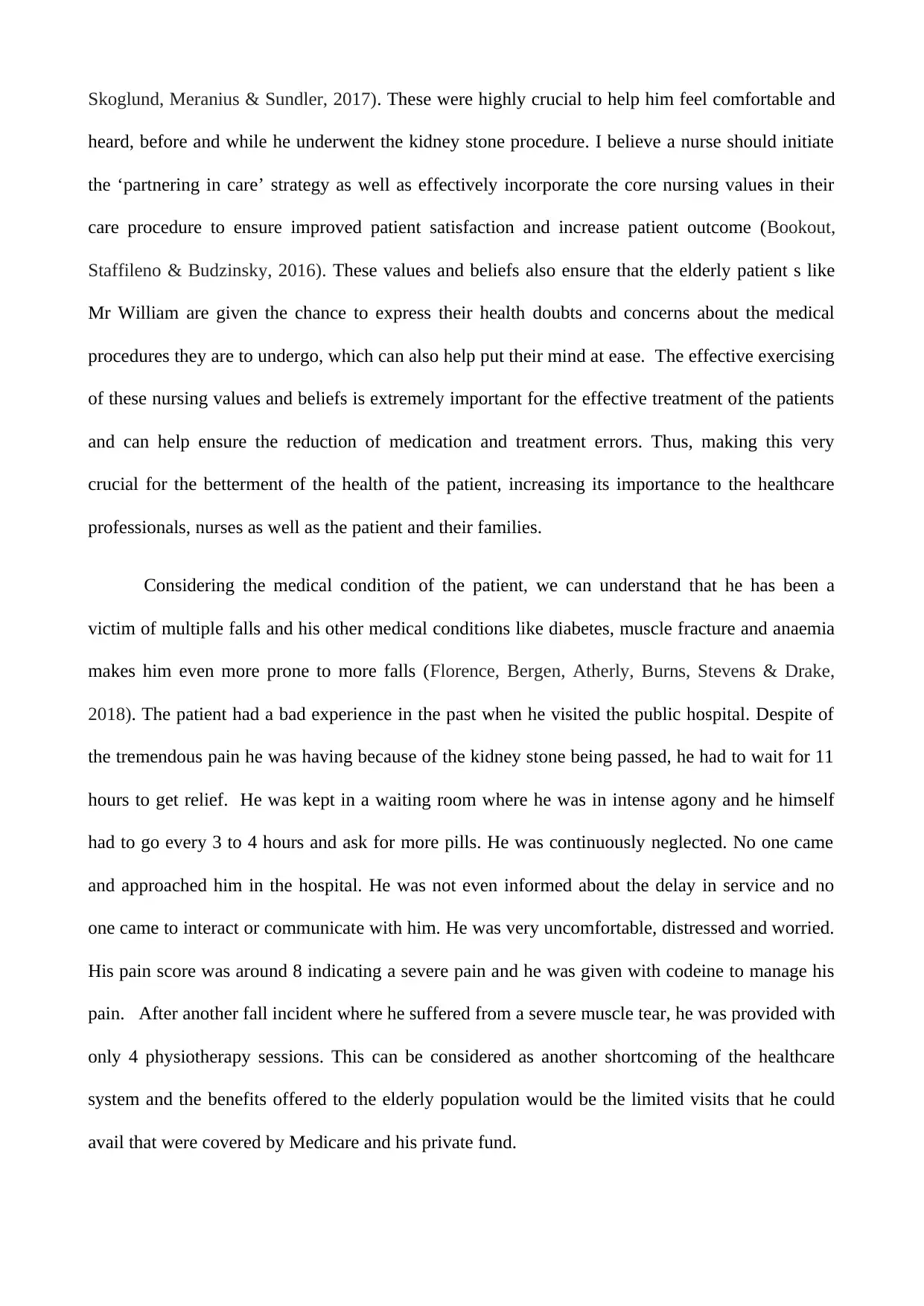
Skoglund, Meranius & Sundler, 2017). These were highly crucial to help him feel comfortable and
heard, before and while he underwent the kidney stone procedure. I believe a nurse should initiate
the ‘partnering in care’ strategy as well as effectively incorporate the core nursing values in their
care procedure to ensure improved patient satisfaction and increase patient outcome (Bookout,
Staffileno & Budzinsky, 2016). These values and beliefs also ensure that the elderly patient s like
Mr William are given the chance to express their health doubts and concerns about the medical
procedures they are to undergo, which can also help put their mind at ease. The effective exercising
of these nursing values and beliefs is extremely important for the effective treatment of the patients
and can help ensure the reduction of medication and treatment errors. Thus, making this very
crucial for the betterment of the health of the patient, increasing its importance to the healthcare
professionals, nurses as well as the patient and their families.
Considering the medical condition of the patient, we can understand that he has been a
victim of multiple falls and his other medical conditions like diabetes, muscle fracture and anaemia
makes him even more prone to more falls (Florence, Bergen, Atherly, Burns, Stevens & Drake,
2018). The patient had a bad experience in the past when he visited the public hospital. Despite of
the tremendous pain he was having because of the kidney stone being passed, he had to wait for 11
hours to get relief. He was kept in a waiting room where he was in intense agony and he himself
had to go every 3 to 4 hours and ask for more pills. He was continuously neglected. No one came
and approached him in the hospital. He was not even informed about the delay in service and no
one came to interact or communicate with him. He was very uncomfortable, distressed and worried.
His pain score was around 8 indicating a severe pain and he was given with codeine to manage his
pain. After another fall incident where he suffered from a severe muscle tear, he was provided with
only 4 physiotherapy sessions. This can be considered as another shortcoming of the healthcare
system and the benefits offered to the elderly population would be the limited visits that he could
avail that were covered by Medicare and his private fund.
heard, before and while he underwent the kidney stone procedure. I believe a nurse should initiate
the ‘partnering in care’ strategy as well as effectively incorporate the core nursing values in their
care procedure to ensure improved patient satisfaction and increase patient outcome (Bookout,
Staffileno & Budzinsky, 2016). These values and beliefs also ensure that the elderly patient s like
Mr William are given the chance to express their health doubts and concerns about the medical
procedures they are to undergo, which can also help put their mind at ease. The effective exercising
of these nursing values and beliefs is extremely important for the effective treatment of the patients
and can help ensure the reduction of medication and treatment errors. Thus, making this very
crucial for the betterment of the health of the patient, increasing its importance to the healthcare
professionals, nurses as well as the patient and their families.
Considering the medical condition of the patient, we can understand that he has been a
victim of multiple falls and his other medical conditions like diabetes, muscle fracture and anaemia
makes him even more prone to more falls (Florence, Bergen, Atherly, Burns, Stevens & Drake,
2018). The patient had a bad experience in the past when he visited the public hospital. Despite of
the tremendous pain he was having because of the kidney stone being passed, he had to wait for 11
hours to get relief. He was kept in a waiting room where he was in intense agony and he himself
had to go every 3 to 4 hours and ask for more pills. He was continuously neglected. No one came
and approached him in the hospital. He was not even informed about the delay in service and no
one came to interact or communicate with him. He was very uncomfortable, distressed and worried.
His pain score was around 8 indicating a severe pain and he was given with codeine to manage his
pain. After another fall incident where he suffered from a severe muscle tear, he was provided with
only 4 physiotherapy sessions. This can be considered as another shortcoming of the healthcare
system and the benefits offered to the elderly population would be the limited visits that he could
avail that were covered by Medicare and his private fund.
Secure Best Marks with AI Grader
Need help grading? Try our AI Grader for instant feedback on your assignments.
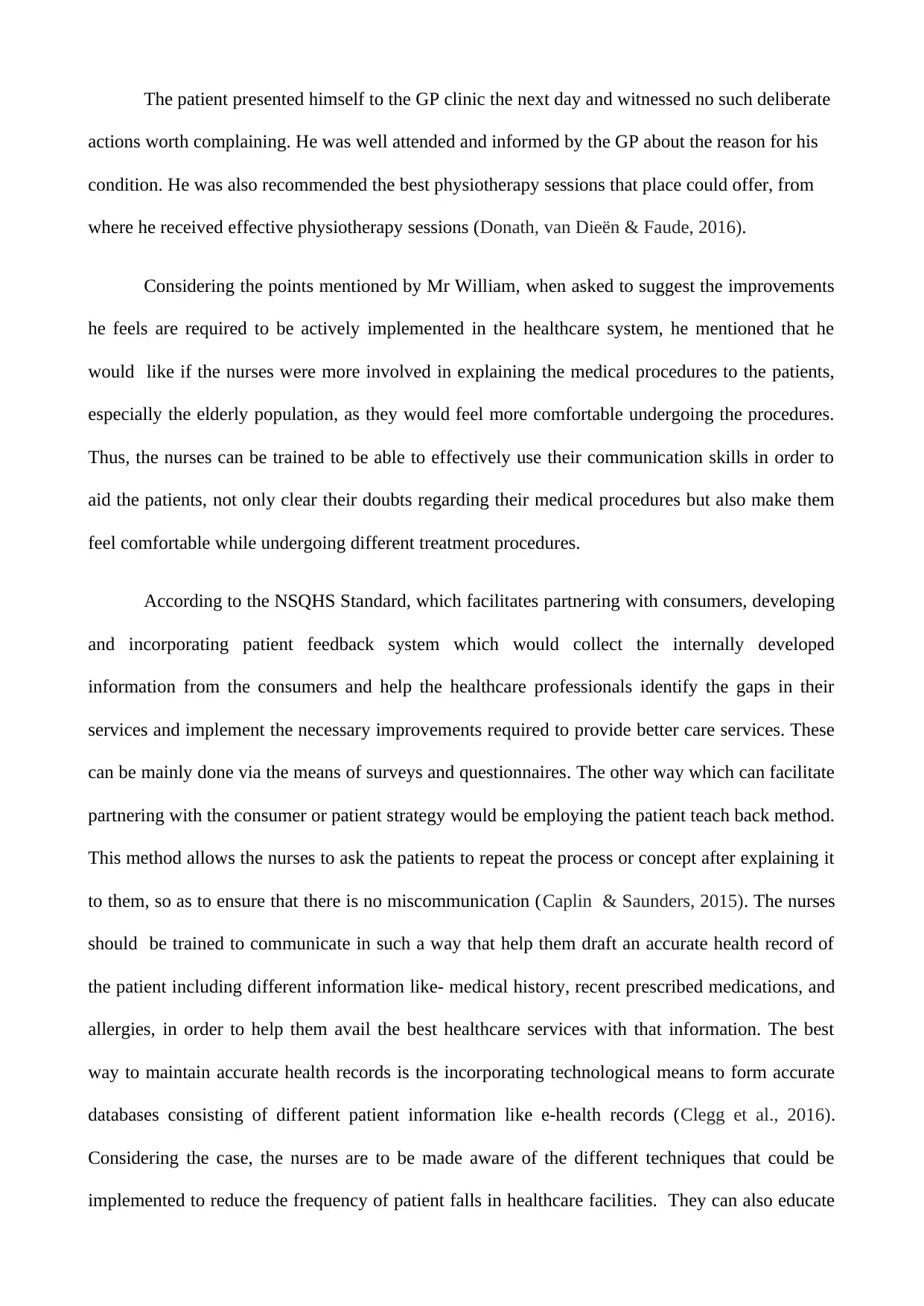
The patient presented himself to the GP clinic the next day and witnessed no such deliberate
actions worth complaining. He was well attended and informed by the GP about the reason for his
condition. He was also recommended the best physiotherapy sessions that place could offer, from
where he received effective physiotherapy sessions (Donath, van Dieën & Faude, 2016).
Considering the points mentioned by Mr William, when asked to suggest the improvements
he feels are required to be actively implemented in the healthcare system, he mentioned that he
would like if the nurses were more involved in explaining the medical procedures to the patients,
especially the elderly population, as they would feel more comfortable undergoing the procedures.
Thus, the nurses can be trained to be able to effectively use their communication skills in order to
aid the patients, not only clear their doubts regarding their medical procedures but also make them
feel comfortable while undergoing different treatment procedures.
According to the NSQHS Standard, which facilitates partnering with consumers, developing
and incorporating patient feedback system which would collect the internally developed
information from the consumers and help the healthcare professionals identify the gaps in their
services and implement the necessary improvements required to provide better care services. These
can be mainly done via the means of surveys and questionnaires. The other way which can facilitate
partnering with the consumer or patient strategy would be employing the patient teach back method.
This method allows the nurses to ask the patients to repeat the process or concept after explaining it
to them, so as to ensure that there is no miscommunication (Caplin & Saunders, 2015). The nurses
should be trained to communicate in such a way that help them draft an accurate health record of
the patient including different information like- medical history, recent prescribed medications, and
allergies, in order to help them avail the best healthcare services with that information. The best
way to maintain accurate health records is the incorporating technological means to form accurate
databases consisting of different patient information like e-health records (Clegg et al., 2016).
Considering the case, the nurses are to be made aware of the different techniques that could be
implemented to reduce the frequency of patient falls in healthcare facilities. They can also educate
actions worth complaining. He was well attended and informed by the GP about the reason for his
condition. He was also recommended the best physiotherapy sessions that place could offer, from
where he received effective physiotherapy sessions (Donath, van Dieën & Faude, 2016).
Considering the points mentioned by Mr William, when asked to suggest the improvements
he feels are required to be actively implemented in the healthcare system, he mentioned that he
would like if the nurses were more involved in explaining the medical procedures to the patients,
especially the elderly population, as they would feel more comfortable undergoing the procedures.
Thus, the nurses can be trained to be able to effectively use their communication skills in order to
aid the patients, not only clear their doubts regarding their medical procedures but also make them
feel comfortable while undergoing different treatment procedures.
According to the NSQHS Standard, which facilitates partnering with consumers, developing
and incorporating patient feedback system which would collect the internally developed
information from the consumers and help the healthcare professionals identify the gaps in their
services and implement the necessary improvements required to provide better care services. These
can be mainly done via the means of surveys and questionnaires. The other way which can facilitate
partnering with the consumer or patient strategy would be employing the patient teach back method.
This method allows the nurses to ask the patients to repeat the process or concept after explaining it
to them, so as to ensure that there is no miscommunication (Caplin & Saunders, 2015). The nurses
should be trained to communicate in such a way that help them draft an accurate health record of
the patient including different information like- medical history, recent prescribed medications, and
allergies, in order to help them avail the best healthcare services with that information. The best
way to maintain accurate health records is the incorporating technological means to form accurate
databases consisting of different patient information like e-health records (Clegg et al., 2016).
Considering the case, the nurses are to be made aware of the different techniques that could be
implemented to reduce the frequency of patient falls in healthcare facilities. They can also educate
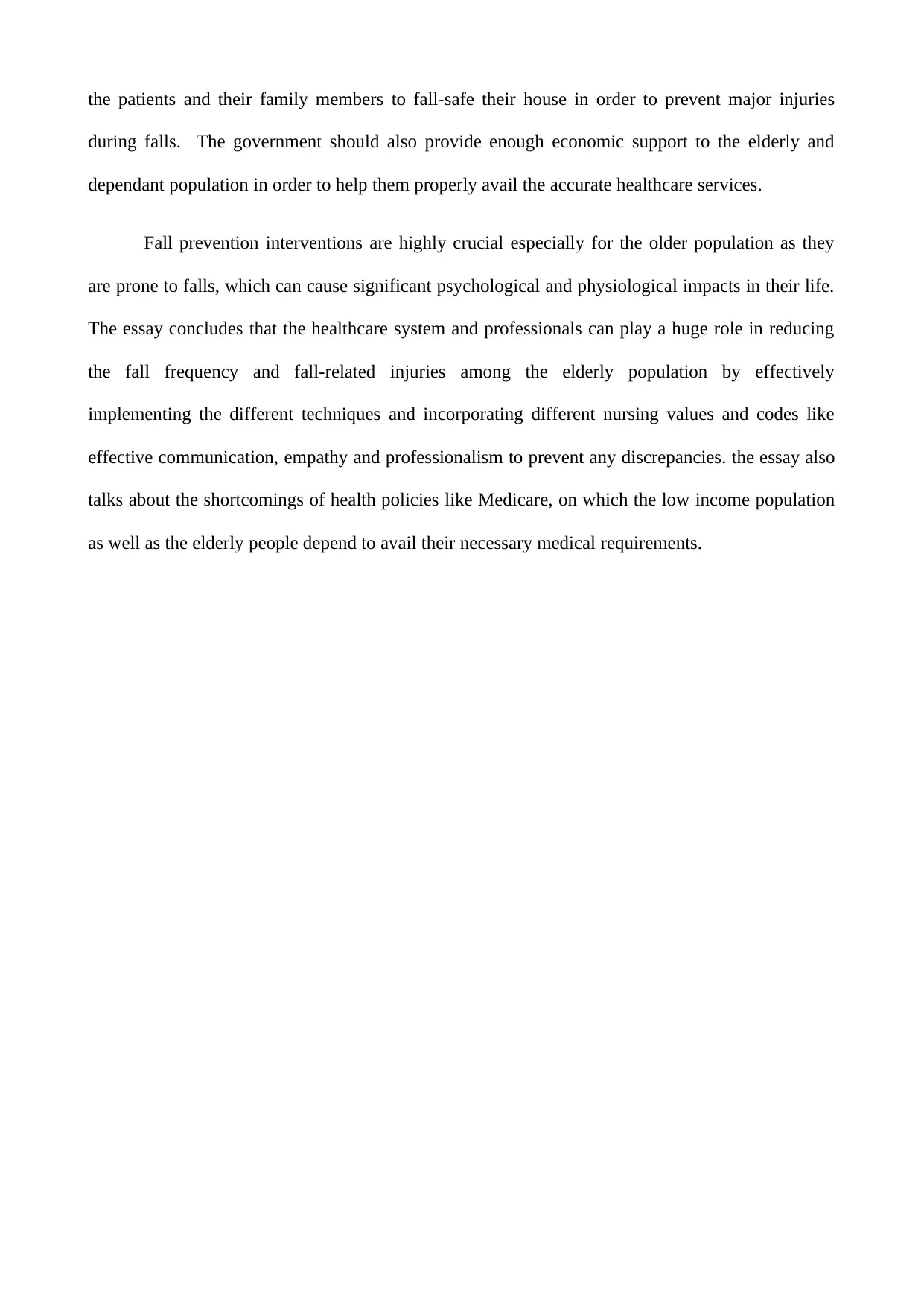
the patients and their family members to fall-safe their house in order to prevent major injuries
during falls. The government should also provide enough economic support to the elderly and
dependant population in order to help them properly avail the accurate healthcare services.
Fall prevention interventions are highly crucial especially for the older population as they
are prone to falls, which can cause significant psychological and physiological impacts in their life.
The essay concludes that the healthcare system and professionals can play a huge role in reducing
the fall frequency and fall-related injuries among the elderly population by effectively
implementing the different techniques and incorporating different nursing values and codes like
effective communication, empathy and professionalism to prevent any discrepancies. the essay also
talks about the shortcomings of health policies like Medicare, on which the low income population
as well as the elderly people depend to avail their necessary medical requirements.
during falls. The government should also provide enough economic support to the elderly and
dependant population in order to help them properly avail the accurate healthcare services.
Fall prevention interventions are highly crucial especially for the older population as they
are prone to falls, which can cause significant psychological and physiological impacts in their life.
The essay concludes that the healthcare system and professionals can play a huge role in reducing
the fall frequency and fall-related injuries among the elderly population by effectively
implementing the different techniques and incorporating different nursing values and codes like
effective communication, empathy and professionalism to prevent any discrepancies. the essay also
talks about the shortcomings of health policies like Medicare, on which the low income population
as well as the elderly people depend to avail their necessary medical requirements.
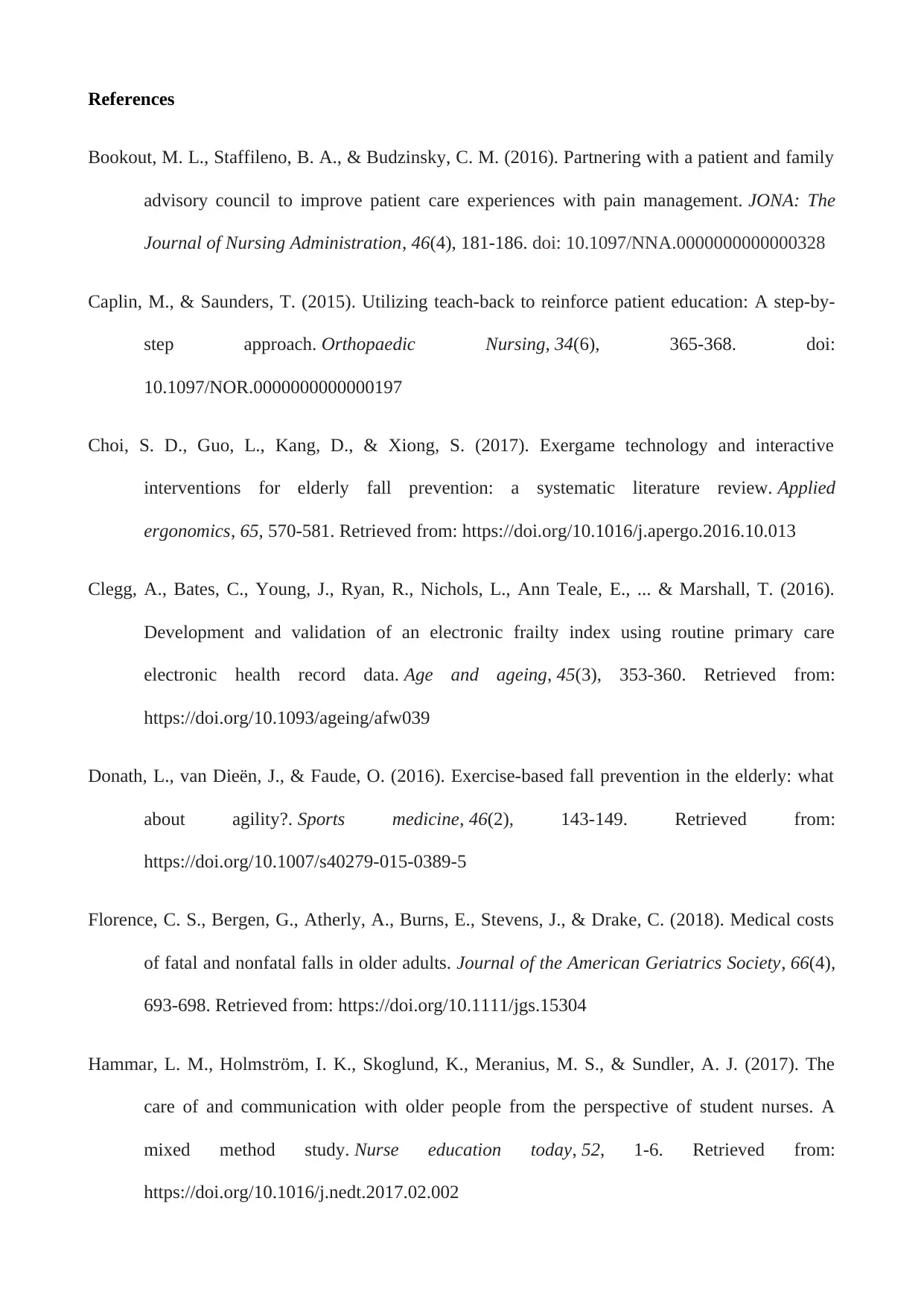
References
Bookout, M. L., Staffileno, B. A., & Budzinsky, C. M. (2016). Partnering with a patient and family
advisory council to improve patient care experiences with pain management. JONA: The
Journal of Nursing Administration, 46(4), 181-186. doi: 10.1097/NNA.0000000000000328
Caplin, M., & Saunders, T. (2015). Utilizing teach-back to reinforce patient education: A step-by-
step approach. Orthopaedic Nursing, 34(6), 365-368. doi:
10.1097/NOR.0000000000000197
Choi, S. D., Guo, L., Kang, D., & Xiong, S. (2017). Exergame technology and interactive
interventions for elderly fall prevention: a systematic literature review. Applied
ergonomics, 65, 570-581. Retrieved from: https://doi.org/10.1016/j.apergo.2016.10.013
Clegg, A., Bates, C., Young, J., Ryan, R., Nichols, L., Ann Teale, E., ... & Marshall, T. (2016).
Development and validation of an electronic frailty index using routine primary care
electronic health record data. Age and ageing, 45(3), 353-360. Retrieved from:
https://doi.org/10.1093/ageing/afw039
Donath, L., van Dieën, J., & Faude, O. (2016). Exercise-based fall prevention in the elderly: what
about agility?. Sports medicine, 46(2), 143-149. Retrieved from:
https://doi.org/10.1007/s40279-015-0389-5
Florence, C. S., Bergen, G., Atherly, A., Burns, E., Stevens, J., & Drake, C. (2018). Medical costs
of fatal and nonfatal falls in older adults. Journal of the American Geriatrics Society, 66(4),
693-698. Retrieved from: https://doi.org/10.1111/jgs.15304
Hammar, L. M., Holmström, I. K., Skoglund, K., Meranius, M. S., & Sundler, A. J. (2017). The
care of and communication with older people from the perspective of student nurses. A
mixed method study. Nurse education today, 52, 1-6. Retrieved from:
https://doi.org/10.1016/j.nedt.2017.02.002
Bookout, M. L., Staffileno, B. A., & Budzinsky, C. M. (2016). Partnering with a patient and family
advisory council to improve patient care experiences with pain management. JONA: The
Journal of Nursing Administration, 46(4), 181-186. doi: 10.1097/NNA.0000000000000328
Caplin, M., & Saunders, T. (2015). Utilizing teach-back to reinforce patient education: A step-by-
step approach. Orthopaedic Nursing, 34(6), 365-368. doi:
10.1097/NOR.0000000000000197
Choi, S. D., Guo, L., Kang, D., & Xiong, S. (2017). Exergame technology and interactive
interventions for elderly fall prevention: a systematic literature review. Applied
ergonomics, 65, 570-581. Retrieved from: https://doi.org/10.1016/j.apergo.2016.10.013
Clegg, A., Bates, C., Young, J., Ryan, R., Nichols, L., Ann Teale, E., ... & Marshall, T. (2016).
Development and validation of an electronic frailty index using routine primary care
electronic health record data. Age and ageing, 45(3), 353-360. Retrieved from:
https://doi.org/10.1093/ageing/afw039
Donath, L., van Dieën, J., & Faude, O. (2016). Exercise-based fall prevention in the elderly: what
about agility?. Sports medicine, 46(2), 143-149. Retrieved from:
https://doi.org/10.1007/s40279-015-0389-5
Florence, C. S., Bergen, G., Atherly, A., Burns, E., Stevens, J., & Drake, C. (2018). Medical costs
of fatal and nonfatal falls in older adults. Journal of the American Geriatrics Society, 66(4),
693-698. Retrieved from: https://doi.org/10.1111/jgs.15304
Hammar, L. M., Holmström, I. K., Skoglund, K., Meranius, M. S., & Sundler, A. J. (2017). The
care of and communication with older people from the perspective of student nurses. A
mixed method study. Nurse education today, 52, 1-6. Retrieved from:
https://doi.org/10.1016/j.nedt.2017.02.002
Paraphrase This Document
Need a fresh take? Get an instant paraphrase of this document with our AI Paraphraser
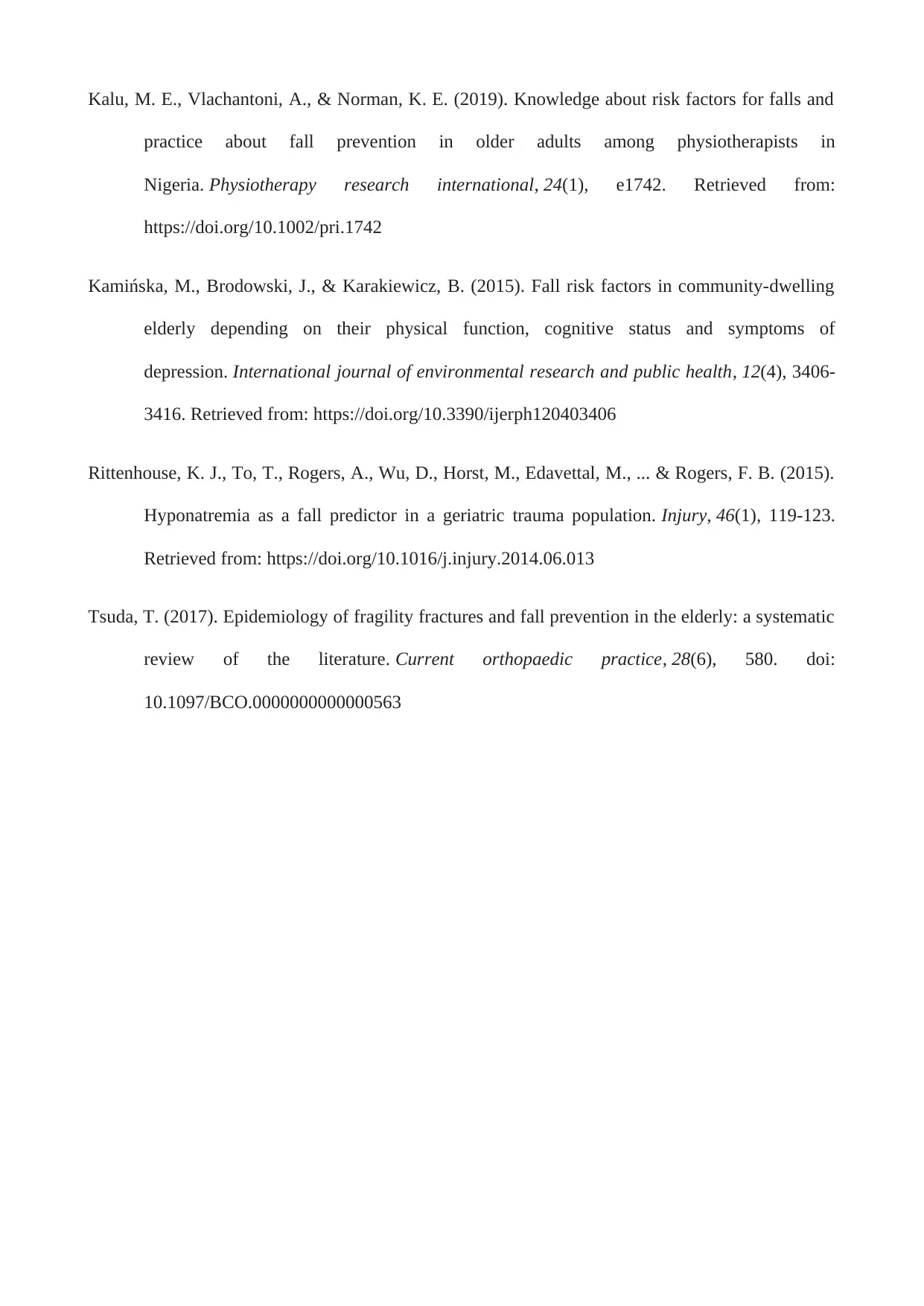
Kalu, M. E., Vlachantoni, A., & Norman, K. E. (2019). Knowledge about risk factors for falls and
practice about fall prevention in older adults among physiotherapists in
Nigeria. Physiotherapy research international, 24(1), e1742. Retrieved from:
https://doi.org/10.1002/pri.1742
Kamińska, M., Brodowski, J., & Karakiewicz, B. (2015). Fall risk factors in community-dwelling
elderly depending on their physical function, cognitive status and symptoms of
depression. International journal of environmental research and public health, 12(4), 3406-
3416. Retrieved from: https://doi.org/10.3390/ijerph120403406
Rittenhouse, K. J., To, T., Rogers, A., Wu, D., Horst, M., Edavettal, M., ... & Rogers, F. B. (2015).
Hyponatremia as a fall predictor in a geriatric trauma population. Injury, 46(1), 119-123.
Retrieved from: https://doi.org/10.1016/j.injury.2014.06.013
Tsuda, T. (2017). Epidemiology of fragility fractures and fall prevention in the elderly: a systematic
review of the literature. Current orthopaedic practice, 28(6), 580. doi:
10.1097/BCO.0000000000000563
practice about fall prevention in older adults among physiotherapists in
Nigeria. Physiotherapy research international, 24(1), e1742. Retrieved from:
https://doi.org/10.1002/pri.1742
Kamińska, M., Brodowski, J., & Karakiewicz, B. (2015). Fall risk factors in community-dwelling
elderly depending on their physical function, cognitive status and symptoms of
depression. International journal of environmental research and public health, 12(4), 3406-
3416. Retrieved from: https://doi.org/10.3390/ijerph120403406
Rittenhouse, K. J., To, T., Rogers, A., Wu, D., Horst, M., Edavettal, M., ... & Rogers, F. B. (2015).
Hyponatremia as a fall predictor in a geriatric trauma population. Injury, 46(1), 119-123.
Retrieved from: https://doi.org/10.1016/j.injury.2014.06.013
Tsuda, T. (2017). Epidemiology of fragility fractures and fall prevention in the elderly: a systematic
review of the literature. Current orthopaedic practice, 28(6), 580. doi:
10.1097/BCO.0000000000000563
1 out of 8
Related Documents
Your All-in-One AI-Powered Toolkit for Academic Success.
+13062052269
info@desklib.com
Available 24*7 on WhatsApp / Email
![[object Object]](/_next/static/media/star-bottom.7253800d.svg)
Unlock your academic potential
© 2024 | Zucol Services PVT LTD | All rights reserved.



